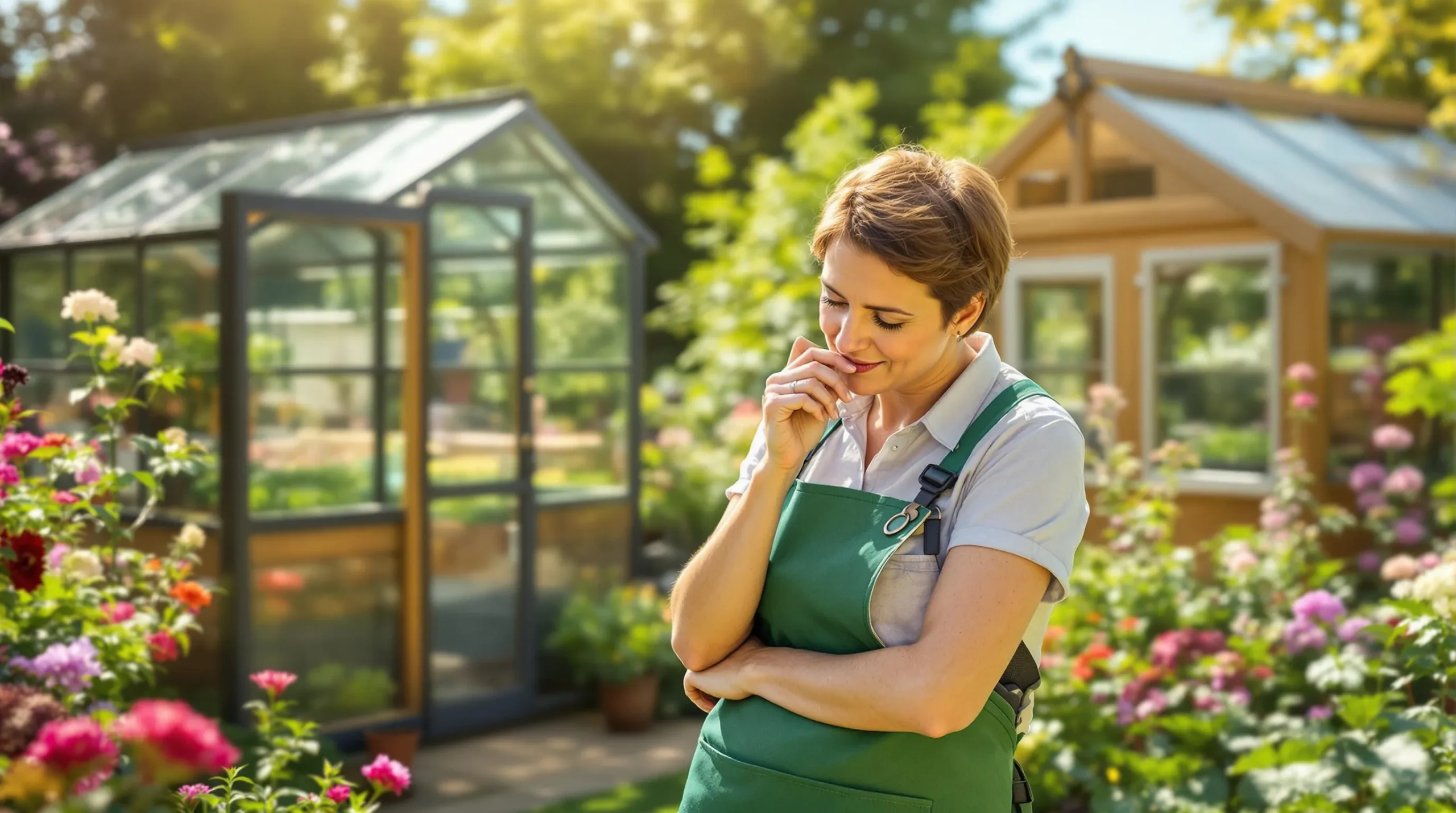
How to Choose Your First Greenhouse: A Complete Beginner’s Guide for 2025
Learn how to choose your perfect first greenhouse with our expert guide. Discover size, materials, and features to extend your growing season by 2-3 months.
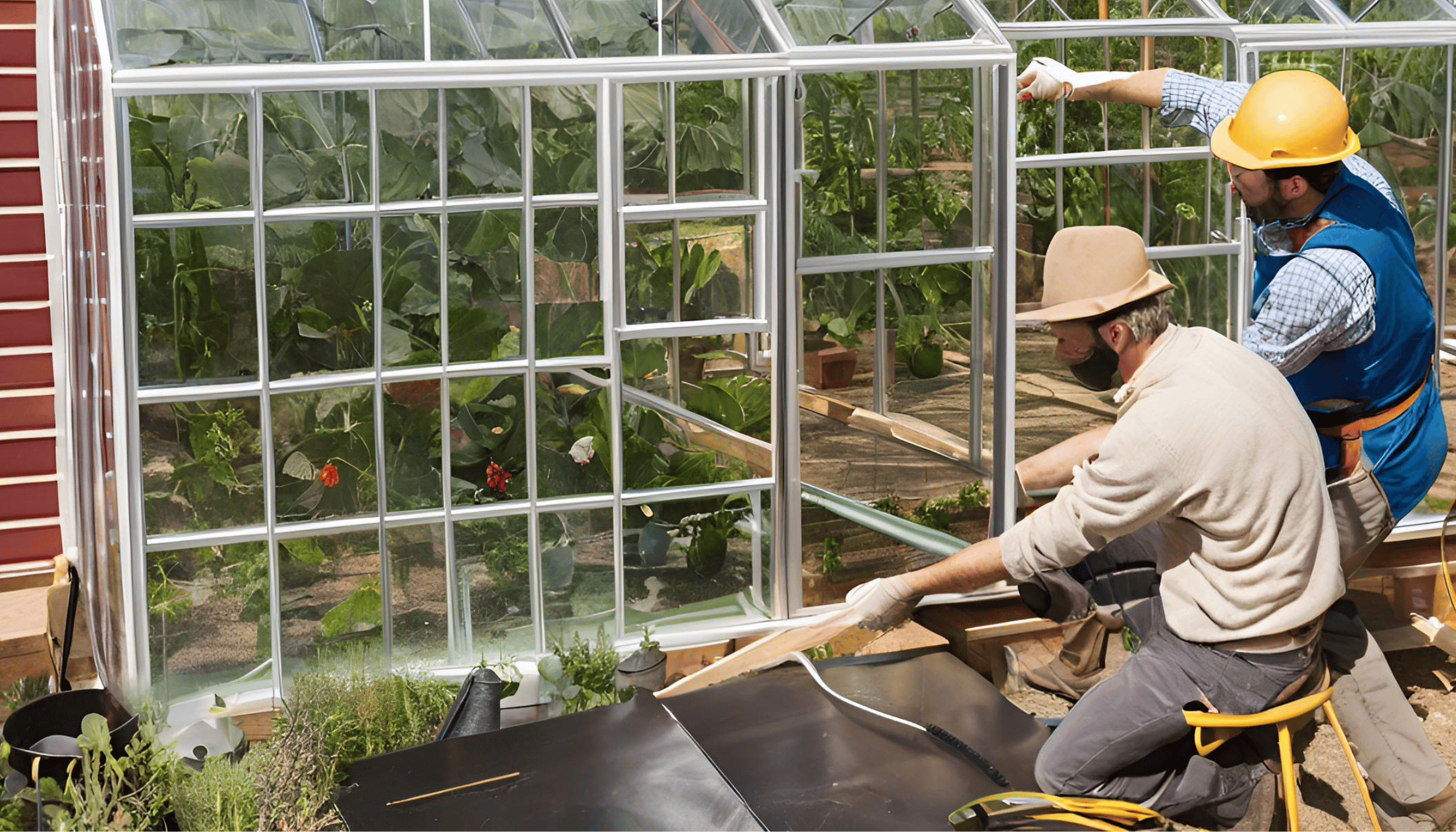
Your greenhouse’s polycarbonate panels must be kept clean to ensure the perfect environment for your plants to thrive. When these panels get dirty, they can block essential sunlight and potentially reduce light transmission significantly, affecting your plants’ growth and overall health. Regular cleaning isn’t just about aesthetics – it’s about maintaining an optimal growing space.
You’ll find that keeping your polycarbonate panels clean is simpler than you might think. With the right approach and gentle cleaning methods, you can maintain their clarity and durability while protecting their UV-resistant properties. Whether you’re dealing with dust, leaves, or stubborn grime, using appropriate cleaning techniques will help preserve your greenhouse panels and ensure they continue to provide the perfect environment for your gardening success.
Regular maintenance helps preserve greenhouse longevity and optimise plant health. Clean polycarbonate greenhouse panels maximise light transmission to create an optimal growing environment for plants.
Regular cleaning of polycarbonate greenhouse panels delivers three essential benefits:
| Benefit | Impact on Greenhouse |
|---|---|
| Light Transmission | Up to 90% with clean panels |
| Panel Durability | 15+ years with proper maintenance |
| Plant Growth Rate | 25-30% faster with optimal light |
Identify these key indicators for panel cleaning:
These signs indicate reduced light transmission through dirty panels. Early cleaning prevents permanent damage and maintains optimal growing conditions.
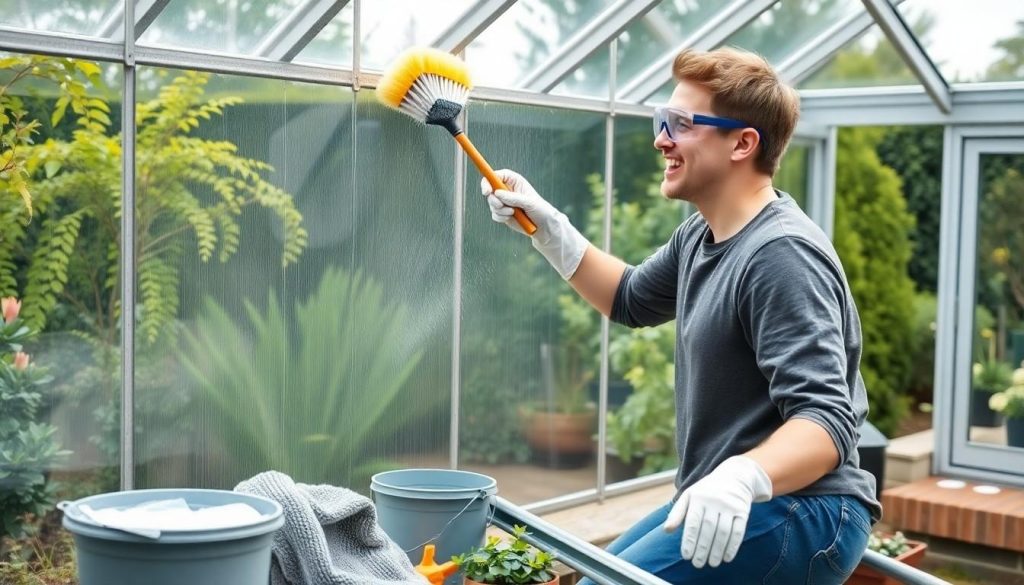
| Equipment Type | Quantity Needed | Replacement Frequency |
|---|---|---|
| Microfiber Cloths | 3-4 pieces | Every 3-4 months |
| Cleaning Solution | 4 litres | Fresh mix each use |
| Soft Sponges | 2-3 pieces | Every 2-3 months |
| Safety Gear | 1 set | Inspect before each use |
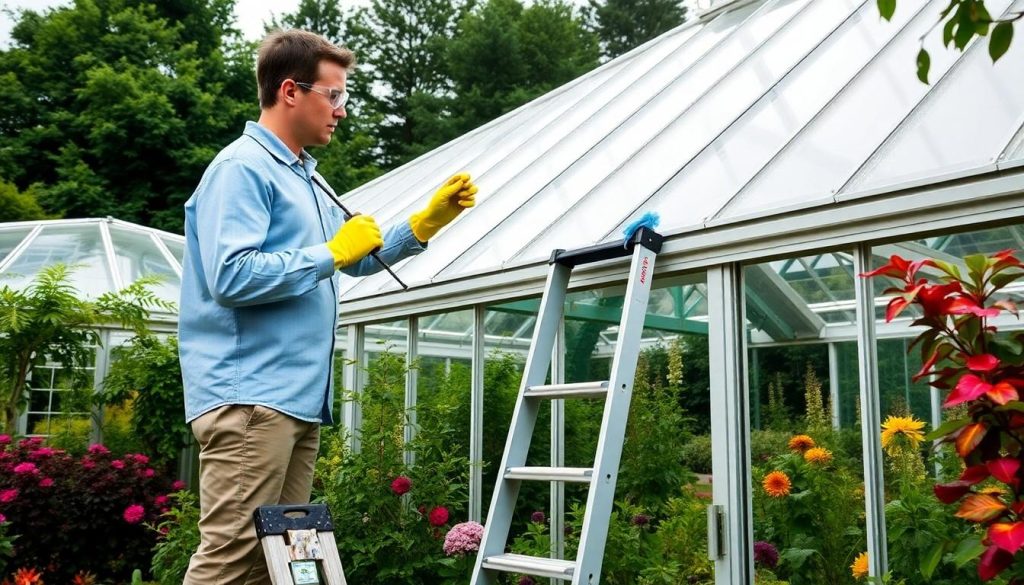
Polycarbonate greenhouse panels can be cleaned safely and effectively with the right preparation. To get the best results, follow to these fundamental steps.
Select the optimal conditions for cleaning your greenhouse panels:
Examine your greenhouse panels to determine cleaning requirements:
This structured preparation creates a foundation for efficient and thorough cleaning while maintaining safety standards throughout the process.
Follow these sequential steps to clean polycarbonate greenhouse panels efficiently.
Remove loose dirt, leaves and debris from the panels using a soft brush or blower. Work from top to bottom in straight lines to prevent scratching the polycarbonate surface. Clear gutters and panel joints of accumulated organic matter to ensure proper water drainage.
Mix 1 tablespoon of mild dish soap per 4 litres of lukewarm water in a bucket. For stubborn stains, create a solution of equal parts white vinegar and water. Apply the cleaning mixture evenly across the panels using a spray bottle. Let the solution sit for 3-5 minutes to dissolve dirt deposits.
Clean the panels using gentle circular motions with a soft microfiber cloth or non-abrasive sponge. Apply light pressure to avoid scratching the surface. Work in manageable sections of 1 square metre at a time. Target stubborn spots with extra solution rather than increased scrubbing pressure.
Rinse each panel thoroughly with clean water from a garden hose, starting at the top and working downward. Remove excess water using a clean rubber squeegee, moving in straight downward strokes. Allow panels to air dry in temperatures above 10°C to prevent water spots.
| Cleaning Stage | Time Required | Water Temperature |
|---|---|---|
| Initial debris removal | 10-15 minutes | N/A |
| Solution application | 3-5 minutes | 20-25°C |
| Scrubbing | 15-20 minutes | N/A |
| Rinsing | 5-10 minutes | 15-20°C |
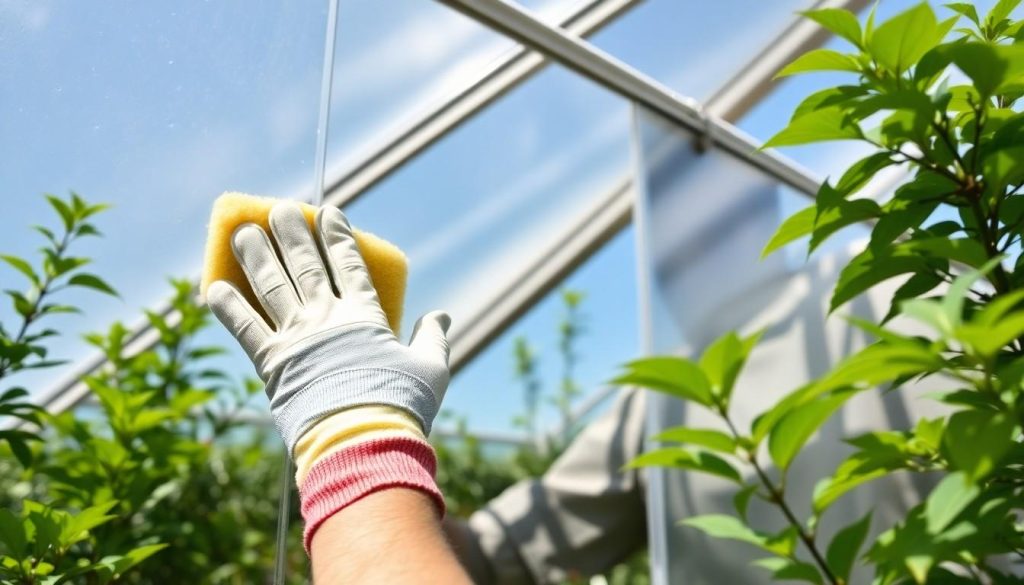
Specific cleaning techniques target common issues that affect polycarbonate greenhouse panels’ transparency and durability.
Mix 1 part white vinegar with 4 parts water to create an effective algae-removal solution. Apply the mixture to affected areas using a soft microfiber cloth and let it sit for 15 minutes. Scrub gently in circular motions with a non-abrasive sponge or soft brush. Rinse thoroughly with clean water and dry with a lint-free cloth.
Common algae growth locations:
Create a paste using equal parts baking soda and water for mineral deposit removal.
Steps for removing hard water stains:
For persistent stains:
Create an antimicrobial cleaning solution using 1 part hydrogen peroxide (3%) to 2 parts water.
Treatment process:
| Treatment Type | Contact Time | Reapplication Frequency |
|---|---|---|
| Algae Solution | 15 minutes | Every 3-4 months |
| Hard Water Treatment | 10 minutes | Every 6 months |
| Mould Treatment | 10 minutes | Every 3 months |
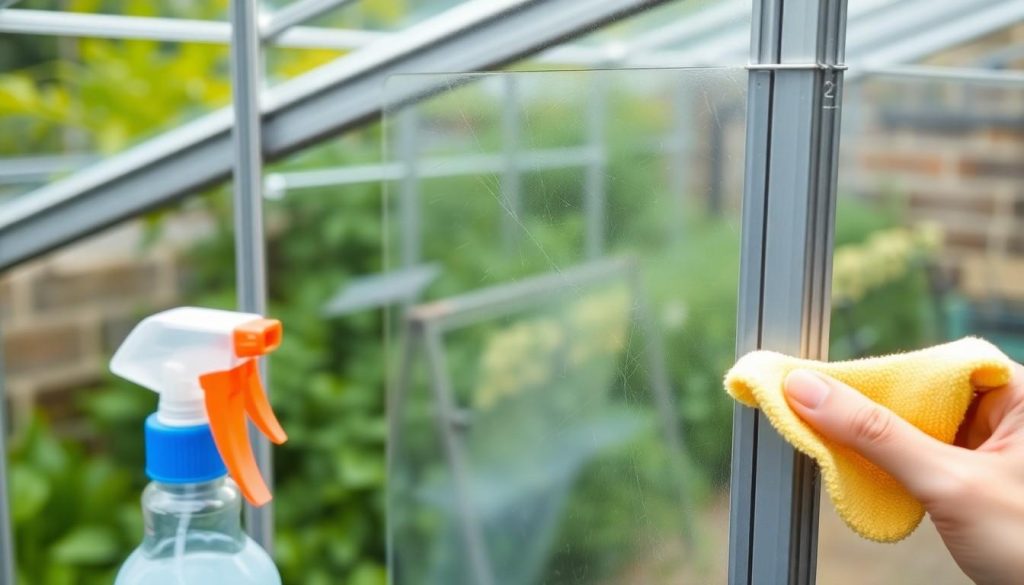
Protect your polycarbonate greenhouse panels by avoiding harmful cleaning methods that cause permanent damage to the material.
| Damaging Item | Type of Damage | Recovery Possibility |
|---|---|---|
| White spirits | Surface haze | Permanent |
| Pressure washer | Panel leaks | Requires replacement |
| Abrasive pads | Surface scratches | Irreversible |
| High alkaline cleaners | Structure weakness | Progressive damage |
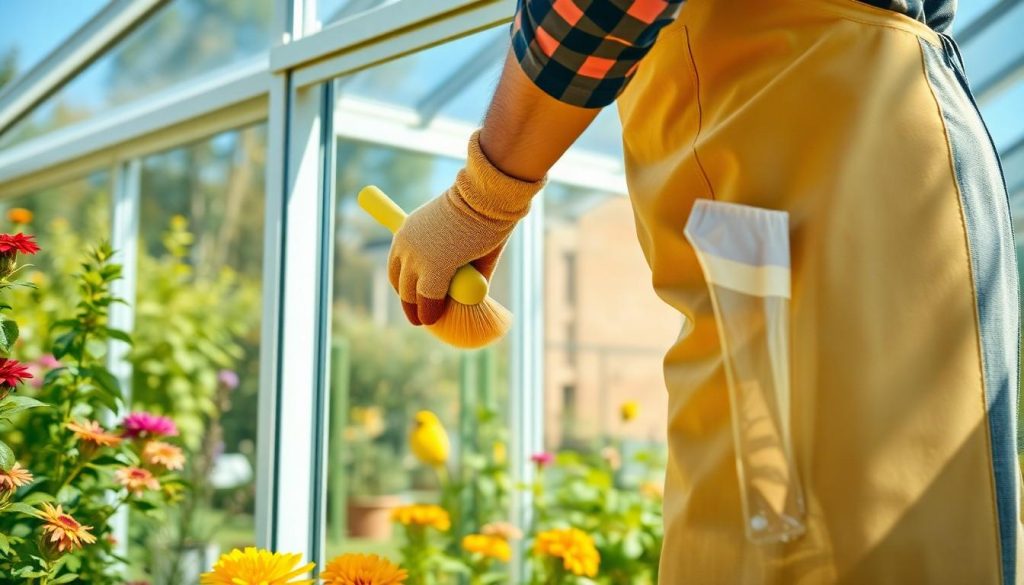
Regular maintenance of polycarbonate greenhouse panels extends their lifespan and maintains optimal light transmission for plant growth. Follow these specific guidelines for effective panel care.
Clean your greenhouse panels 4 times per year:
Create a cleaning calendar with specific tasks:
Apply these protective measures to reduce cleaning frequency:
| Season | Temperature Range | Primary Tasks | Frequency |
|---|---|---|---|
| Spring | 10-15°C | Pollen removal | Bi-weekly |
| Summer | 15-20°C | Algae control | Weekly |
| Autumn | 10-15°C | Leaf clearing | Weekly |
| Winter | 5-10°C | Snow removal | As needed |
Spring:
Summer:
Autumn:
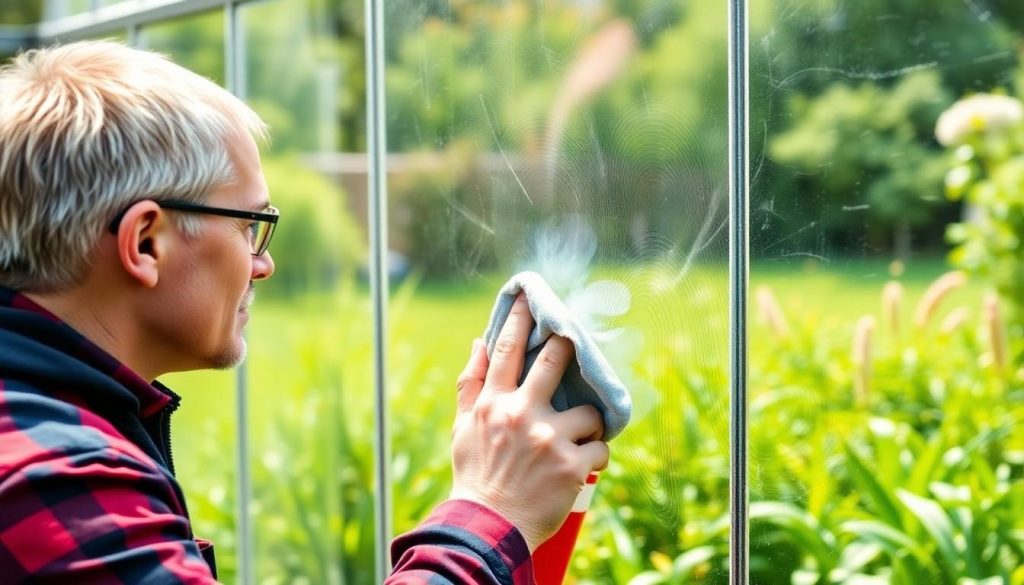
Common issues with polycarbonate greenhouse panels require specific repairs to maintain their clarity and functionality.
Surface scratches on polycarbonate panels decrease light transmission and affect plant growth. Here’s how to address scratches:
Stubborn stains on polycarbonate panels require targeted cleaning approaches:
| Type of Damage | Signs | Solution |
|---|---|---|
| UV Degradation | Yellowing panels | Apply UV protective coating |
| Frost Damage | Crackling surface | Install thermal insulation |
| Storm Impact | Loose fixings | Tighten or replace fixtures |
Keeping your polycarbonate greenhouse panels clean is key to giving your plants the best growing conditions. Regular cleaning helps maximise light transmission and extends the life of your panels.
Use gentle cleaning methods and the right tools to keep your greenhouse clear and in top shape. A little maintenance goes a long way in ensuring healthy plants and a well-functioning greenhouse.
By making panel cleaning a routine part of your gardening, you’ll create a thriving growing space that supports strong, abundant harvests all year round.
Clean your panels at least four times a year, with additional cleaning as needed. Regular maintenance includes quarterly deep cleans and monthly light cleaning. In dusty or high-pollen areas, you might need to clean more frequently. Regular cleaning maintains optimal light transmission and prevents permanent staining.
Use a mixture of mild dish soap and lukewarm water for regular cleaning. For stubborn stains, a 50/50 vinegar-water solution is effective. Avoid harsh chemicals, commercial glass cleaners, or abrasive cleaners that can damage the panels’ protective coating.
No, pressure washers should never be used on polycarbonate panels. The high-pressure water can damage the protective UV coating and potentially cause structural damage. Instead, use a regular garden hose with moderate pressure for rinsing.
Apply a solution of equal parts white vinegar and water to affected areas. Gently scrub with a soft-bristled brush, working in circular motions. Rinse thoroughly with clean water. For prevention, ensure good ventilation and reduce moisture levels in your greenhouse.
Essential tools include a soft-bristled brush, microfiber cloths, non-abrasive sponges, a garden hose, and a squeegee. You’ll also need safety equipment like non-slip gloves, safety goggles, and sturdy footwear.
Look for visible surface deposits, water marks, algae growth, reduced interior brightness, and changes in plant growth rates. If you notice your greenhouse is darker inside or plants aren’t thriving as well, it’s time to clean the panels.
Choose an overcast day with temperatures between 10-20°C. Avoid cleaning in direct sunlight, which can cause cleaning solutions to dry too quickly and leave marks. Also avoid windy conditions and freezing temperatures.
With proper maintenance and regular cleaning, polycarbonate panels can last over 15 years. Regular cleaning helps maintain light transmission efficiency and prevents permanent damage, significantly extending the panels’ lifespan.

Learn how to choose your perfect first greenhouse with our expert guide. Discover size, materials, and features to extend your growing season by 2-3 months.
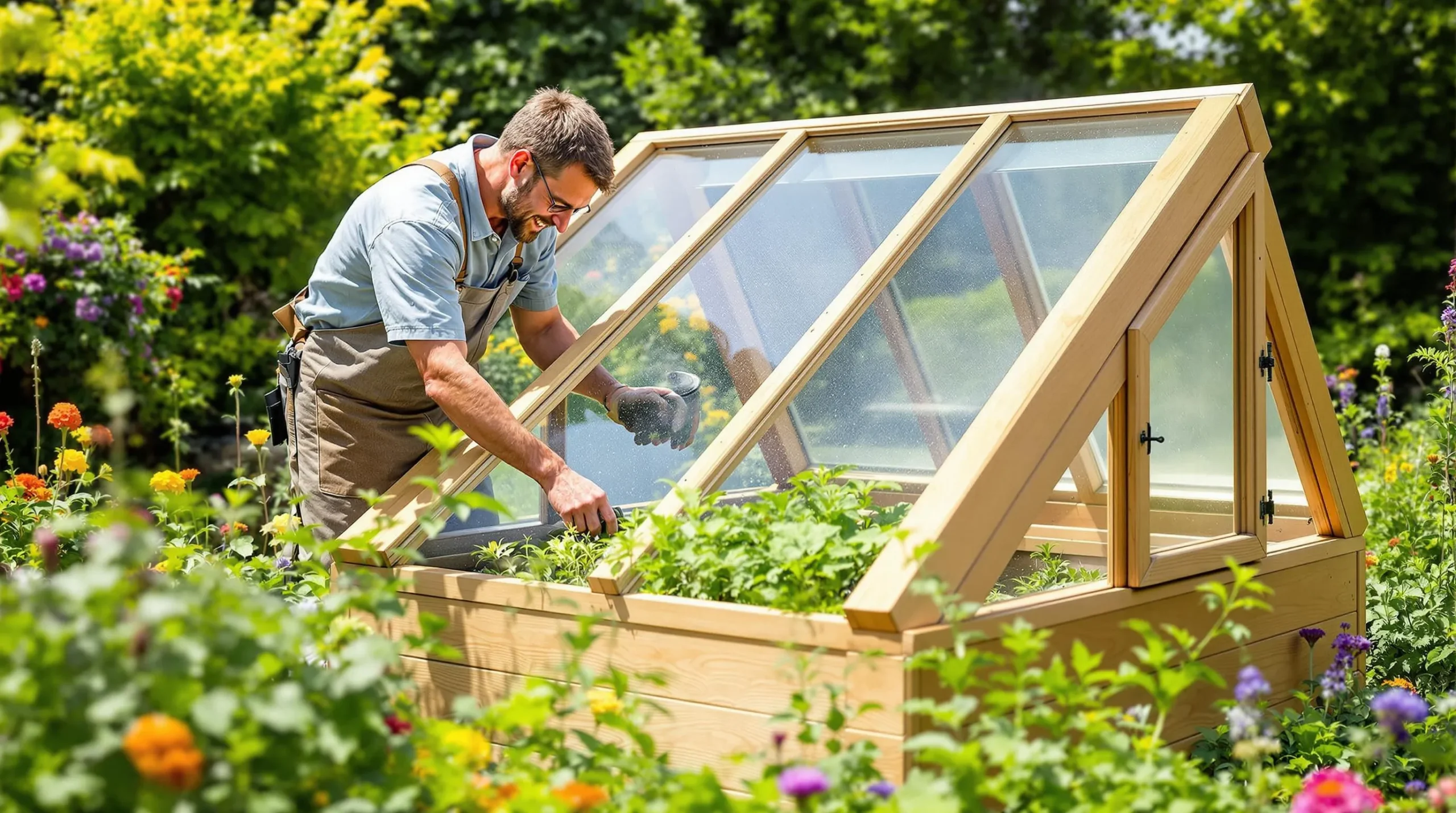
Learn how to make a cold frame to extend your growing season, protect plants in winter, and grow seedlings all year. Simple, cost-effective, and DIY-friendly!